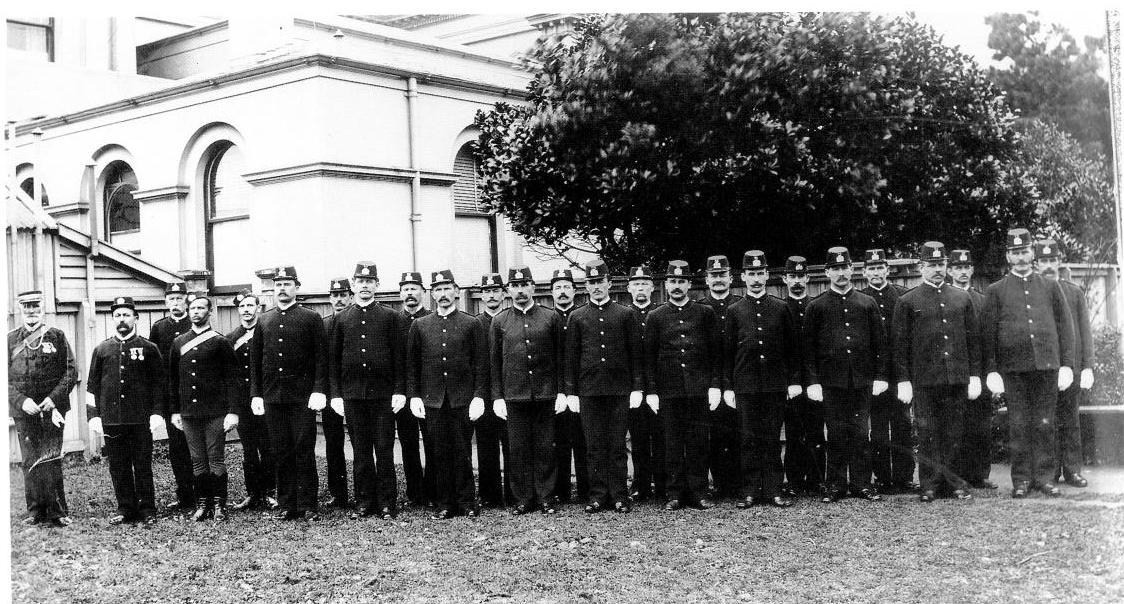Sergeant William Mason
New Zealand's early police officers were well known in the towns which they watched over. Often they would go out of their way to gain the public's trust and friendship to allow them to do their duties to the best of their abilities.
New Zealand's early police officers were well known in the towns which they watched over. Often they would go out of their way to gain the public's trust and friendship to allow them to do their duties to the best of their abilities.
One such man was William Thomas Mason. Born in the town of Chatham, Kent sometime around 1845, Mr Mason came out on the Silver Eagle as a soldier of the 43rd Regiment who'd been sent to help in the Taranaki Wars that were raging in the North Island of New Zealand. During his service he was present at some of the most important and famous of skirmishes such as Nukumaru, Okotuku and Gate Pā. For five years he fought as a soldier then in 1868 joined the Armed Constabulary at Patea and saw further service at the West Coast, Tauranga and Opotiki during the 'Te Kooti trouble'. In 1869 he won the prize of 20 pounds for being the best shot in the Constabulary and in about 1876 he became a Sergeant Major.
After the wars he began policing throughout the country in places such as Auckland, Wellington, Lyttleton, Christchurch, Timaru and Blenheim. It was while at Opotiki he married his first wife Sarah Ellen Sullivan. Together they raised a family of eight children. Unfortunately, On the 26th May, 1886 at Sumner Road, Lyttelton. Sarah passed away. William is also said to have "made the sensational arrest of Handale (Allendale) one of the greatest of New Zealand criminals" however, I have never heard of this person.
In 1899 after being in charge of various districts William was ordered to head to Marlborough which he did so. At the time he left he was working at Lambton Quay, Wellington police station and was given a grand send off.
In Marlborough William took charge of almost every case there was in the region from sheep stealing to drunk and disorderly to drownings. He was praised by the community and was eager to keep everything in ship shape condition. He and his second wife had two more children in the district.
However, On the 10th of June, 1906 after a long and successful career William was injured at the Wairau Ferry Bridge. While he and his second wife (Marion Elizabeth Shanahan) were descending the northern approach to the Bridge the horse that was pulling their trap stumbled which sent William flying out of the trap and he landed head first on the ground. He was rushed to the Ferry Hotel where one Dr. Bennett was called for. He in turn called for an ambulance and William was rushed to the Wairau Hospital. It became apparent that he'd badly fractured the base of his skull. He was put out of work for a time but it would seem that the time was shortened by William's eagerness to get back to work, for just a few months later he was helping with cases, one in particular was the recovery of the bodies of Annie Bonnington and her infant in the Wairau River. He apparently rode up and down the river for a few days until he eventually found them.
The accident unfortunately had some lasting consequences. He became less out going and was happy with stepping back and letting others take the reigns. He didn't talk as much and was happy with the idea of retirement. This was vastly different from the man that he used to be. Ken Fairweather, grandson of William, remembered that he was very quiet and never talked about the New Zealand Wars. The accident is likely to have been the reason.
In 1908 the family lost their youngest addition; Irene Mary Maude. Irene was only 11 years old at the time. She was interred in Omaka cemetery.
In 1910 William was gifted a silver mounted walking stick as a token of the esteem he was held in. This was a year after he retired from the force. William became slower and slower till eventually, On the 19th of October, 1913 William passed away after a career that spanned 50 years. He was the last member of the Armed Constabulary still in the force when he retired. He had the New Zealand Wars and Long-Service medals in his possession at the time of his death and a wealth of friends, comrades and family who would have been present at the funeral. His pall bearers were Constables Doggett, Cummings, Quayle, King, Byrne and Williams. He was buried with his daughter Irene and wife Marian who passed away in August of the same year. His headstone also remembers his daughter Deborah though she is buried in Wakapuaka Cemetery in Nelson. Though William's story is not a well known one he is still an important figure in the New Zealand policing history. He has many descendants still in the district of Marlborough and in New Zealand as a whole and will continue to be remembered as a devoted soldier and policeman.
2019 (updated August 2020)
Story by: Thomas Fairweather
Further Sources
Websites
- William Mason. Death notice (1913, October 20) Marlborough Express:
https://paperspast.natlib.govt.nz/newspapers/MEX19131020.2.17
